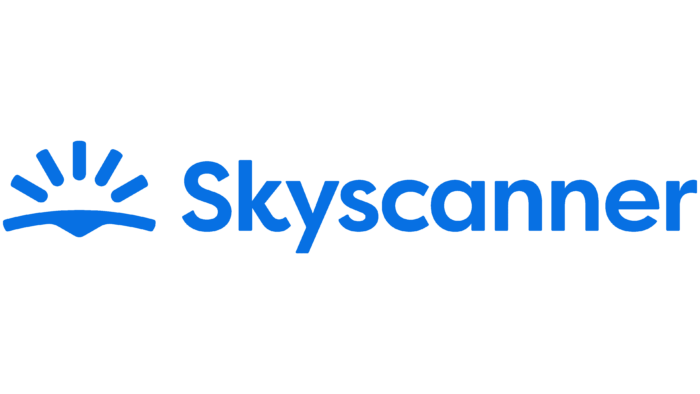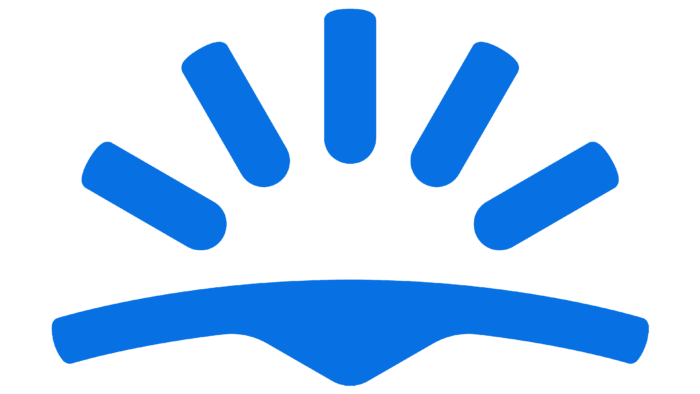The Skyscanner logo isn’t just dynamic, and it’s hyperactive. At least visually. Designers have filled it with elements that seem to move due to their location. This perfectly conveys the concept of a service that helps people travel.
Skyscanner: Brand overview
| Founded: | 2003 |
| Founder: | Gareth Williams, Barry Smith, Bonamy Grimes |
| Headquarters: | Edinburgh, Scotland, UK |
| Website: | skyscanner.com |
Meaning and History
Skyscanner entered the tourism market in 2003. Three IT people founded it: Bonamy Grimes, Barry Smith, and Gareth Williams. It all started with the fact that one of them was going to fly on vacation but could not find cheap plane tickets. This inspired computer experts to start an unusual startup. Together they developed a website that combined search results from various online travel agencies to compare prices on selected flights.
Now it is used by tens of millions of people, and modern features of the service allow you to book tickets directly. Travelers freely pay for them and, at the same time, order additional services, including car rental and travel insurance.
Such a sharp leap in the development of Skyscanner is reflected in the emblem of this company. If the old symbol hinted only at air travel, then the modern version presents a universal sign associated with tourism. The brand image was last updated in 2019. The designers tried to keep the traditional structure of the logo: a combination of an icon and a company name.
What is Skyscanner?
Skyscanner started as an online flight search tool until it evolved into a true full-service travel agency. Its headquarters is based in the capital of Scotland – in the city of Edinburgh. At the same time, the brand is owned by the Chinese company Trip.com Group Limited, which bought it in 2016.
2002 – 2006
Even though the Skyscanner organization was officially registered in 2003, the site of the same name appeared a year earlier. Its emblem consisted of three differently directed arrows. They looked like three pyramid ribs (top view) because one of them looked to the upper left corner, the second – down, and the third – to the upper right corner. The center was the starting point from where travel began. Three arrows symbolize a large selection of flights that allow you to travel to any part of the world. On the other hand, the junction of the lines can be interpreted as a Skyscanner user. The arrows, in turn, can indicate the global scope of the search for air tickets using the online service.
On the right was the brand name, written in two different fonts. The first three letters (“SKY”) were uppercase. Their typeface was reminiscent of SoftMaker’s Quebec Serial Heavy, S-Core’s Core Sans B 55 Bold, or Paulo Pedott’s Doris PP bold. The end of the word was converted to lowercase but differed from the first part only in glyphs because the designers equalized all the letters in size. His typeface was roughly similar to Transmute Light by Typodermic Fonts Inc. The three-arrow symbol and “SKY” were dark blue, while the “scanner” was gray.
2006 – 2008
In 2006, the logo creators reduced the graphic symbol and moved it slightly higher. At the same time, they repainted all the elements in a new shade of blue and lowercase “SKY” to make the inscription look harmonious. The new typeface looked like a cross between Ligurino SemiCondensed Book by Typodermic Fonts Inc. and Oslo Bold by Wilton Foundry.
2008 – 2012
In 2008, the investment company Scottish Equity Partners allocated a large sum of money to develop Skyscanner. Meanwhile, the online service has changed its logo. The designers made the lines of the arrows a little thicker and slightly corrected the inscription. In particular, they slightly increased the intra-letter gaps of “e” and “a,” straightened the lower part of the stem of “y,” and expanded “c.” Adobe has a similar typeface. It’s called Myriad Hebrew Regular.
2012 – 2015
With the advent of 2012, Skyscanner has a new office in Beijing and an equally new logo that differs from the previous version. The obsolete symbol of three arrows has been replaced with a schematic representation of a cloud – a symbol of air travel. It was light blue but not solid: the left side of the emblem was streaked with white rounded lines, reminiscent of fragments of concentric rings: only three white stripes with a small circle in the middle. This element was similar to a radar signal for detecting airborne objects.
The brand name was in bold gray italics. Its closest counterpart is Hand Foundry’s Bronkoh Bold Italic, although the lowercase “a” looks like the corresponding letter from Durotype’s Aspira XNar Demi Italic.
2015 – 2019
The next logo changes took place in 2015. But they were not global: the company only updated the color, repainting the cloud and the inscription in one common light blue color (#00b3d7). The hue matched in all parts, even though the left side visually seemed darker.
2019 – today
The turning point in the history of visual identity Skyscanner came in 2019. As the service expanded from being just a flight comparison metasearch engine to a travel company, it needed a universal sign. The cloud did not meet this criterion because it was associated with gloomy weather and did not inspire travel. The designers removed the variable cloudiness icon and replaced it with the opposite symbol – a radiant sun.
London-based studio Koto and more than 50 Skyscanner in-house designers worked on the brand’s new image. Together, they came up with a revolutionary concept, embodying four elements: discoveries, ideas, stability, and optimism. The icon reflects these aspects, which consists of a curved strip with a triangle at the bottom and five short lines resembling the sun’s rays. The image is adapted for mobile devices because statistics showed that 60% of smartphone Skyscanner customers access the site.
The brand name, as before, is located on the right side. Colophon created a new sans-serif typeface for it, Skyscanner Relative. The first “S” is capitalized, and the lower diagonal “k” is unusually curled up. The color of the logo is dark blue.
Font and Colors
The Skyscanner graphic sign is shaped like the bottom of a swimsuit, so the associations with leisure and travel are obvious. Of course, the designers did not put such a meaning into the emblem. The large curved band represents the Earth and the horizon in particular. A small triangle pointing downwards symbolizes an arrow that points to a destination. And five dashes, built in the form of an arch, represent the sunrise.
The Skyscanner Relative corporate font was specially developed for the company logo. The author of this grotesque is Colophon. Proportional, symmetrical letters look harmoniously in combination with the rounded lines of the emblem. The color scheme is based on a rich shade of sky blue (#0770e3). It reflects the first part of the brand name (“Sky”) and establishes a connection with the old Skyscanner graphic signs.
Skyscanner color codes
| Sky Blue | Hex color: | #0770e3 |
|---|---|---|
| RGB: | 7 112 227 | |
| CMYK: | 97 51 0 11 | |
| Pantone: | PMS 2727 C |












